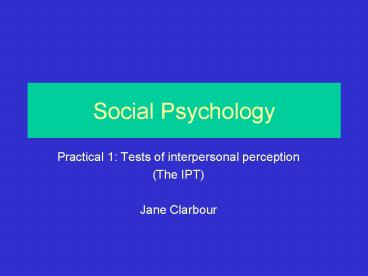Social Psychology - PowerPoint PPT Presentation
1 / 8
Title:
Social Psychology
Description:
Title: PowerPoint Presentation Author: Jane Clarbour Last modified by: Jane Clarbour Created Date: 11/14/2001 3:12:31 PM Document presentation format – PowerPoint PPT presentation
Number of Views:26
Avg rating:3.0/5.0
Title: Social Psychology
1
Social Psychology
- Practical 1 Tests of interpersonal perception
- (The IPT)
- Jane Clarbour
2
Objectives
- Discuss cultural differences in nonverbal
perceptual sensitivity in the context of social
skills - Specify some of the cues which people use in
making judgements in person perception - Examine your own perceptual sensitivity
- Identify which communication cues have particular
significance in your interpretation of social
scenes
3
The IPT
- The Interpersonal Perception Task (IPT) is about
nonverbal communication and social perception - 30 brief scenes (30 60 secs each)
- Each scene is paired with a question that has
different possible answers - The viewers task is to decode something about
the people in each scene
4
Objectivity
- The IPT is an objective test
- In each scene of the IPT, there is an objectively
correct answer to the question asked. - For each scene the events did occur and there is
a correct answer to the question - The IPT is a measure of how accurately
individuals identify different types of nonverbal
communication present in each scene
5
Channels of nonverbal communication
- All the IPT scenes contain spontaneous
naturalistic behaviour - Facial expression
- Tone of voice
- Hesitations
- Eye movements
- Gestures
- Personal space
- Posture
- Touching behaviour
6
ITP Types of Scenes
- Six examples each of the following types of
scenes - Status
- Intimacy
- Kinship
- Competition
- Deception
7
Theoretical background
- Nonverbal cues supply important information about
people (Ekman Friesen, 1975) - Recognition of emotion from a facial expression
in 1/24th Sec exposure (Rosenthal et al. 1979) - Social intelligence (Archer, 1980) enables us
to interpret other peoples behaviour, feelings,
and relationships from a single photo - Nonverbal clues can be more powerful and reliable
than verbal cues (Archer Akert, 1977).
8
Reliability and validity
- Good stability (5 week retest reliability) of IPT
(r .70 n 46 college students) - Poor internal consistency (KR-20 .52 n 438)
- Diversity of items?
- Moderate concurrent validity
- Correlation with measure of Interpersonal
perception (r .48 df 16, p lt 0.05) - The IPT is culturally biased































